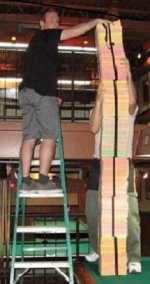This is what 500,000 racks of Eight, Nine, and Ten-Ball look like. There are between 10 and 20 racks per score sheet. It took two employees and a ladder to prop up this colossal stack. Every last break was executed under the “No Conflict Rules” (shoot what you break). The players recorded their performance on every break. 95% of this was casual play where pool time was paid. The remainders are score sheets from tournaments. And yes, there are score sheets from 5 current US Open players. This does not count the thousands of breaks done in our leagues.
My point: The rules are acceptable. They work and the picture is my proof.
The rules do exactly what they were designed to do: 1) end the racking and breaking problems, 2) give advantage to the better player, 3) speed up play 4) make the matches more exciting. There is no need for a neutral racker, a special racking gadget, or anyone to check the rack. It is so easy. The pool experience and competition becomes better for all players at all levels.
The problems that have plagued racking and breaking for decades will continue until our sport is rid of the ball-on the-break. It takes a ton of skill to control the cue-ball, control the 1-ball, get a good spread, and get a shot. That is good enough.
I purchased the live streaming for my customers this week. We watched a premier match last night, as I am sure many did. The new rules were supposed to be some kind of fix. They are not. I watched two of the best players in the world “cheat the rack” over and over (svb & orc). This is so very destructive. I am disgusted, ashamed, and embarrassed. Some of these matches are won by what goes on before the balls are even broke. Is this what my crop of players is supposed to emulate? Should I even be showing this?
I know this has gotten repetitious and old but I will continue to do what I do and encourage others to do the same. It is good for our sport.
My point: The rules are acceptable. They work and the picture is my proof.
The rules do exactly what they were designed to do: 1) end the racking and breaking problems, 2) give advantage to the better player, 3) speed up play 4) make the matches more exciting. There is no need for a neutral racker, a special racking gadget, or anyone to check the rack. It is so easy. The pool experience and competition becomes better for all players at all levels.
The problems that have plagued racking and breaking for decades will continue until our sport is rid of the ball-on the-break. It takes a ton of skill to control the cue-ball, control the 1-ball, get a good spread, and get a shot. That is good enough.
I purchased the live streaming for my customers this week. We watched a premier match last night, as I am sure many did. The new rules were supposed to be some kind of fix. They are not. I watched two of the best players in the world “cheat the rack” over and over (svb & orc). This is so very destructive. I am disgusted, ashamed, and embarrassed. Some of these matches are won by what goes on before the balls are even broke. Is this what my crop of players is supposed to emulate? Should I even be showing this?
I know this has gotten repetitious and old but I will continue to do what I do and encourage others to do the same. It is good for our sport.
Attachments
Last edited:
